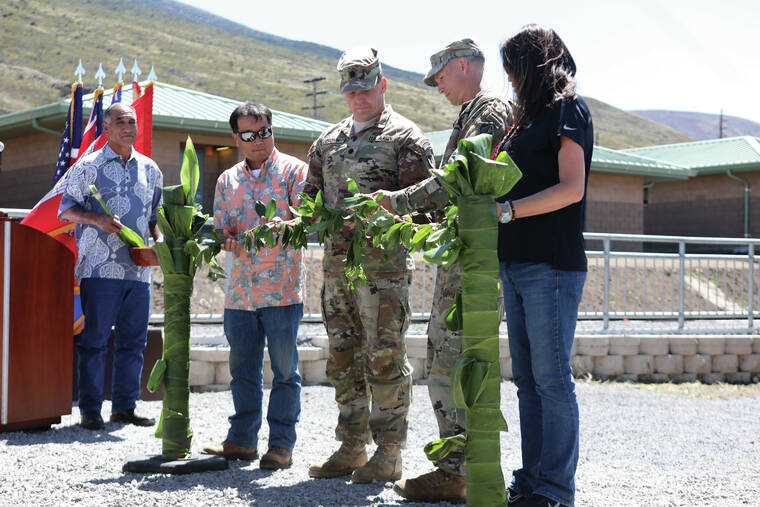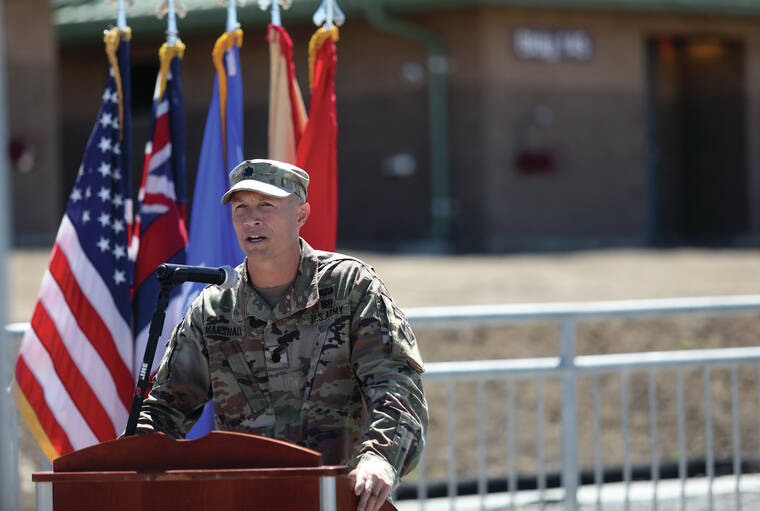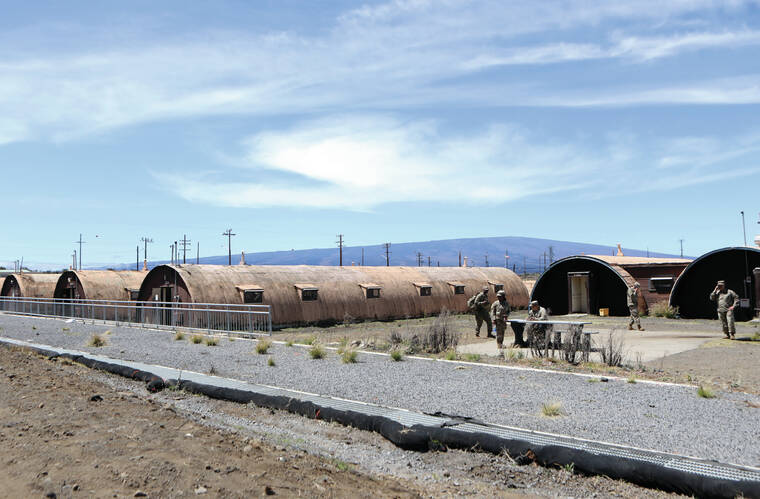New barracks unveiled at Pohakuloa Training Area

Kelsey Walling/Tribune-Herald Lt. Col. Kevin Cronin gives a speech Tuesday to thank everyone involved with the new barracks at Pohakuloa Training Are.

Kelsey Walling/Tribune-Herald Lt. Col. Kevin Cronin and Lt. Col. Eric Marshall untie a lei to officially open the new barracks at the Pohakuloa Training Area on Tuesday.

Kelsey Walling/Tribune-Herald Lt. Col. Eric S. Marshall speaks during a ceremony Tuesday to celebrate the new barracks at Pohakuloa Training Area.

Army members walk and talk outside the Quonset huts at Pohakuloa Training Area. The huts are gradually being replaced with modern barracks. (Kelsey Walling/Hawaii Tribune-Herald)

Two people look at the new barracks at the Pohakuloa Training Area on Tuesday. The barracks have replaced Quonset huts that were built in the 1950s. (Photos by Kelsey Walling/Hawaii Tribune-Herald)
Two rows of new barracks were unveiled at the Pohakuloa Training Area during a ceremony held Tuesday.
Two rows of new barracks were unveiled at the Pohakuloa Training Area during a ceremony held Tuesday.
The result of a $17 million contract, the 10 new barracks replaced the Quonset huts originally constructed as easy-to-assemble, temporary buildings during the early 1950s.
“When I look at these new barracks, I see something reliable and dependable,” said Lt. Col. Eric S. Marshall, 72nd Honolulu District Commander, who helped oversee the project. “These Quonset huts lasted 70 years or so, not bad, but these are going to last a lot longer.”
The ceremony also marked the completion of a drainage project, the result of an additional $20 million contract.
The barracks are the first step in an ongoing effort to replace all Quonset huts located on PTA’s roughly 132,000 acres, the largest military training area in the Pacific.
During their demolition, materials containing asbestos were found throughout the huts.
“This project exhausted almost all of its contingency funds to dispose of that asbestos,” said Marshall. “That’s just one example of the adversity this team has been through.”
The new barracks are ready for immediate use, with the next two rows expected to start construction in 2024.
“That’s a very fluid date,” said Lt. Col. Kevin Cronin, garrison commander of PTA. “It’s a phased plan, and given budgetary constraints, it’s about 10 years for the rest of the barracks to be built.”
Despite their replacement, Cronin is hoping to preserve the legacy of the Quonset huts. PTA’s Quonset hut chapel is reportedly the only one in the U.S. Army.
“Over time, all the Quonset huts will be replaced,” said Cronin. “But we’ve got a Quonset hut theater and chapel, and I would like to preserve those structures to connect them as a mark of where we came from.”
The new barracks were a collaboration with Nakasato Contracting, LLC, responsible for subcontracting several Big Island companies for the project.
“We employed a women-owned small business,” said Marshall of Nakasato. “It’s really important for us to spread federal funds for projects like this. Infrastructure is good, but we’re also making sure that the local economy is benefiting.”
It’s estimated the entire $210 million overhaul of PTA could create roughly 261 construction jobs per year.
Future projects include demolishing and replacing roughly 110 additional single-story buildings, constructing 41 more barracks, 13 laundry/latrine/shower points, 25 administration buildings, five dining facilities, three medical and emergency services buildings, one storage building, two community buildings and five industrial buildings, all pending available funding.
“With legacy must come change, progress and improvement,” Cronin said. “These new barracks are now a part of our living legacy.”
Currently, PTA can accommodate a maximum of 2,300 soldiers.
“For engineers, we have no place else in the Pacific for a heavy equipment operator to push the kind of dirt and gravel that’s necessary to mimic wartime conditions,” Marshall said. “We have no other place we can do demolition charges. We have no other place where we can do fire maneuver like we can here.”
The barracks and drainage ceremony was attended by Mayor Mitch Roth, Councilman Tim Richards, a kahu who blessed the barracks, several former PTA commanders and generals, as well as members of the public.
“This project was very much a team effort, and it’s great to have so many members of the community join us,” Cronin told attendees as he thanked the American Red Cross, Hawaii police and fire departments and PTA’s 230-member team for their assistance.
PTA has several community outreach programs planned for this year including “Experience PTA Day,” which will return for the first time in three years following COVID-19 restrictions. Local students will be able to tour the training area and learn about its day-to-day operations.
“We are united on a mission, another kuleana, to protect a way of life that is very unique and precious to the people of the Big Island,” Marshall said. “It’s a pleasure for me to be a part, in a small way, of helping to protect a way of life in Hawaii that is precious and unique. We take that very seriously.”
Email Grant Phillips at gphillips@hawaiitribune-herald.com


